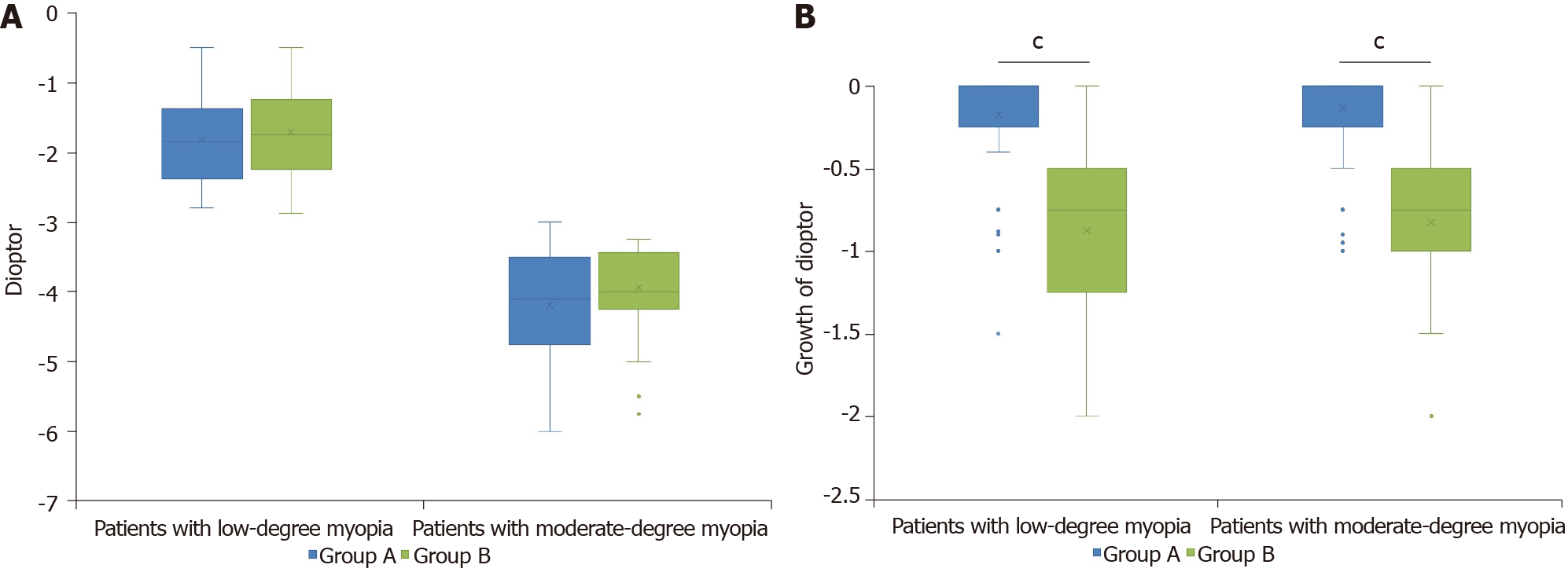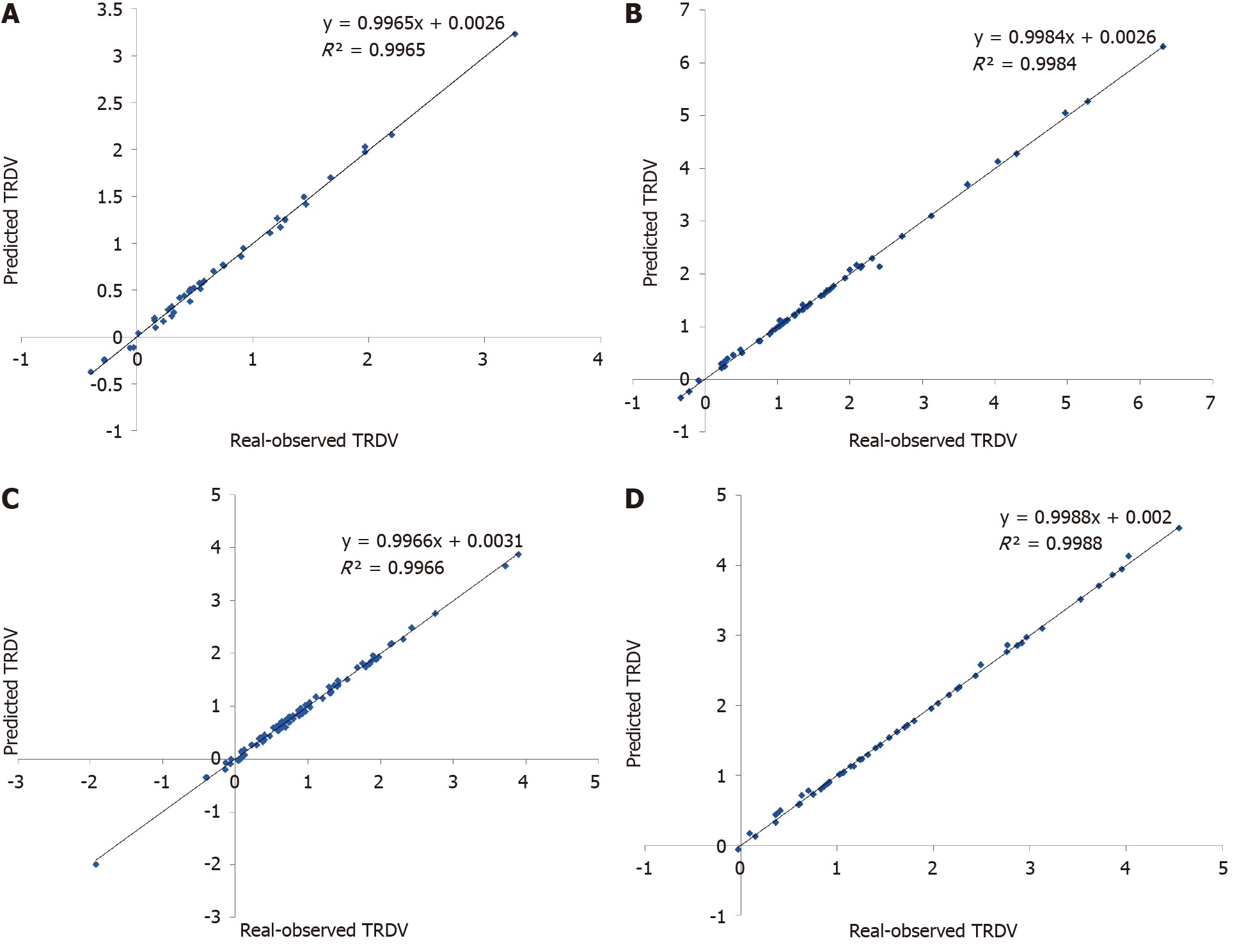Copyright
©The Author(s) 2021.
World J Clin Cases. Oct 26, 2021; 9(30): 8985-8998
Published online Oct 26, 2021. doi: 10.12998/wjcc.v9.i30.8985
Published online Oct 26, 2021. doi: 10.12998/wjcc.v9.i30.8985
Figure 1 Original diopter values and diopter increase in the two groups.
A: Original diopter values. Of patients with low-degree myopia: Group A: n = 41, mean ± standard deviation (SD) = -1.82 ± 0.71; Group B: n = 59, mean ± SD = -1.71 ± 0.64. Of patients with moderate-degree myopia: Group A: n = 83, mean ± SD = -4.19 ± 0.82; Group B: n = 54, mean ± SD = -3.94 ± 0.62; B: Growth of diopter. Of patients with low-degree myopia: Group A: mean ± SD = -0.17 ± 0.34; Group B: mean ± SD = -0.88 ± 0.39. Of patients with moderate-degree myopia: Group A: mean ± SD = -0.13 ± 0.22; Group B: mean ± SD = -0.82 ± 0.37. N was the number of eyes. Boxes indicate the 1st, 2nd, and 3rd quartile, whiskers represent the maximum and minimum value, and x indicates mean value. Statistically significant differences between patients treated differently were determined by a Mann-Whitney test (cP ≤ 0.001). Group A: Myopia patients wearing orthokeratology lenses for 1 year; Group B: Myopia patients wearing frame glasses.
Figure 2 Axis length and its change after 1-year treatment in the groups.
A: Original ocular axial length. No significant differences between two groups were verified by a Student test (P ≥ 0.05). Of patients with low-degree myopia: Group A: n = 28, mean ± standard deviation (SD) = 24.33 ± 0.70 (mm); Group B: n = 54, mean ± SD = 24.01 ± 0.76 (mm). Of patients with moderate-degree myopia: Group A: n = 64, mean ± SD = 25.40 ± 0.90 (mm); Group B: n = 48, mean ± SD = 25.23 ± 0.65 (mm); B: Changes of axis length. Statistically significant differences between patients treated by different ways were determined by a Mann-Whitney test (cP ≤ 0.001). In low myopia groups: Group A: n = 28, mean ± SD = 0.25 ± 0.15 (mm); Group B: n = 54, mean ± SD = 0.45 ± 0.19 (mm). In moderate myopia groups: Group A: n = 64, mean ± SD = 0.18 ± 0.11 (mm); Group B: n = 48, mean ± SD = 0.39 ± 0.14 (mm). N was the number of eyes. Boxes indicate the 1st, 2nd, and 3rd quartile, whiskers represent the maximum and minimum value, and x indicates mean value. Group A: Myopia patients wearing orthokeratology lenses for 1 year; Group B: Myopia patients wearing frame glasses.
Figure 3 Comparison of total retinal defocus value in the two groups.
Patients with low-degree myopia: Group A: n = 41, mean ± SD = 0.73 ± 0.75; Group B: n = 59, mean ± SD = 1.58 ± 1.31. Patients with moderate -degree myopia: Group A: n = 83, mean ± SD = 0.91 ± 0.89; Group B: n = 54, mean ± SD = 1.66 ± 1.15. Boxes indicate the 1st, 2nd, and 3rd quartile, respectively, whiskers represent the maximum and minimum value, and x indicate mean value. Statistically significant differences between patients treated differently were determined by a Mann-Whitney test (cP ≤ 0.001). TRDV: Total retinal defocus value; Group A: Myopia patients wearing orthokeratology lenses for 1 year; Group B: Myopia patients wearing frame glasses.
Figure 4 Scatterplots showing the relationship between total retinal defocus value and defocus values of peripheral retina.
A: Showing retinal defocus values (RDVs) of patients with low-degree myopia in group A (R2 = 0.877); B: Showing RDVs of patients with low-degree myopia in group B (R2 = 0.668); C: Showing RDVs of patients with moderate-degree myopia in group A (R2 = 0.618); D: Showing RDVs of patients with moderate-degree myopia in group B (R2 = 0.498).
Figure 5 Scatterplots showing the relationship between total retinal defocus value and retinal defocus value of the nasal side of the retina of patients with moderate-degree myopia in group B.
A, E, I, and M: Retinal defocus value of the upper; B, F, J, and N: Retinal defocus value of lower; C, G, K, and O: Retinal defocus value of temporal; D, H, L, and P: Retinal defocus value of nasal. TRDV: Total retinal defocus value; RDV: Retinal defocus value; RDV-S: Retinal defocus value of the upper; RDV-I: Retinal defocus value of lower; RDV-T: Retinal defocus value of temporal; RDV-N: Retinal defocus value of nasal.
Figure 6 Scatterplots showing the relationship between the predicted value and real-observed total retinal defocus value.
A: Linear regression between predicted total retinal defocus value (TRDV) and observed value low-degree myopia patients of Group A; B: Linear regression between predicted TRDV and observed value low-degree myopia patients of Group B; C: Linear regression between predicted TRDV and observed value moderate-degree myopia patients of Group A; D: Linear regression between predicted TRDV and observed value moderate-degree myopia patients of Group B. TRDV: Total retinal defocus value.
- Citation: Ni NJ, Ma FY, Wu XM, Liu X, Zhang HY, Yu YF, Guo MC, Zhu SY. Novel application of multispectral refraction topography in the observation of myopic control effect by orthokeratology lens in adolescents. World J Clin Cases 2021; 9(30): 8985-8998
- URL: https://www.wjgnet.com/2307-8960/full/v9/i30/8985.htm
- DOI: https://dx.doi.org/10.12998/wjcc.v9.i30.8985














